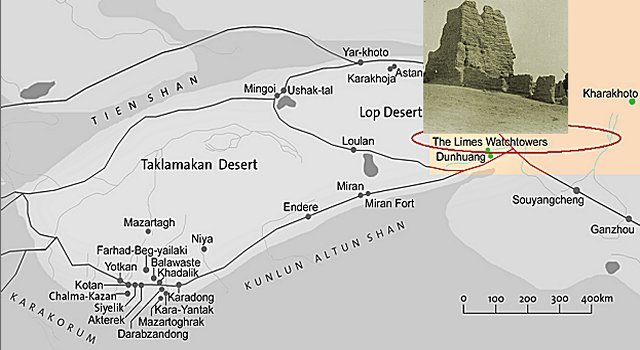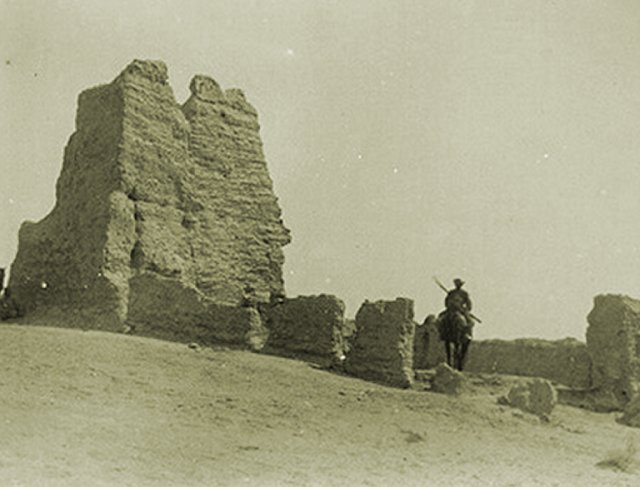Sir Marc Aurel Stein: Famous Fascinating Expeditions To Ancient Places Of The Silk Road
A. Sutherland - AncientPages.com - Sir Aurel Stein (1862 – 1943), British archaeologist, explorer famous for his archaeological discoveries in Central Asia, was fascinated by the history of the Silk Road.
For many years, Stein conducted scientific and archaeological excavations in various Asian countries and a large part of the exhibits at the British Museum and British Library comes from Stein's exploration.
 Aurel Stein’s view of Mogao Cave 16, in Dunhuang, Gansu Province, China, with a number of manuscripts from Cave 17 bundled on the floor. After Aurel Stein, Serindia: Detailed report of explorations in Central Asia and westernmost China (Oxford: Clarendon Press, 1932), vol. 2, fig. 200
Aurel Stein’s view of Mogao Cave 16, in Dunhuang, Gansu Province, China, with a number of manuscripts from Cave 17 bundled on the floor. After Aurel Stein, Serindia: Detailed report of explorations in Central Asia and westernmost China (Oxford: Clarendon Press, 1932), vol. 2, fig. 200
In March 1907, during his second expedition to Central Asia, Stein visited Dunhuang, an important city on the trade route known as the Silk Road, and learned about the Dunhuang Mogao grottoes.
Using a small bribe he convinced Wang Yuanlu, a Taoist monk to sell him 12 boxes of manuscripts, painted on silk. In June 1907 years Stein smuggled them out of Dunhuang, and in August 1908 took them from China.
In May of 1900, Stein began his first trip to western China and the Taklamakan Desert. This trip lasted nearly two years. He discovered beautiful Buddhist sculptures, paintings, and Sanskrit texts. At Niya - an archaeological site about 115 km (71 mi) on the southern edge of the Tarim Basin in modern-day Xinjiang, China, Stein found many priceless artifacts.
Among them more than 100 wooden tablets written in 105 CE, with clay seals, official documents written in an early Indian script. Other his discoveries included a carved stool, a mousetrap, a part of the guitar, a bow, and more.
The first expedition made him a famous man.
Stein also visited the site known as the Limes Watchtowers, fortified encampments located north of Dunhuang in northwest China, along the edges of the Taklamakan Desert. They extend the wall completed by Emperor Qin Shi Huangdi (259-210 BC) in 214 BC as a barrier against the Xiongnu.
Under the Han Dynasty (206 BC-220 AD) the walls were carried over 1,600 kilometers to the west, to the easternmost edge of the Tarim Basin - where a series of mummies discovered in present-day Xinjiang, China.
The walls and beacon towers protected China's trade and military colonies and served as a base for expansion into Central Asia.
They were made of stamped clay and gravel, alternating with layers with wood, to protect against corrosion by wind-blown sand. They were completed in less than a century with water carried over huge distances.
Behind the walls lay a series of watchtowers in varying in size, some as much as twenty feet square and as lofty as 30-40 feet. These housed small numbers of soldiers who watched the desert and signaled to armies stationed at nearby Dunhuang through a system of couriers and fire signals.
In one case, Stein gives some details regarding the towers:
"The watch-tower, built entirely of regular courses of hard clay about four inches thick, with thin layers of tamarisk branches laid between them, still rose to over twenty-two feet. In order to give additional cohesion to the solid base measuring about twenty feet square, numerous wooden posts had been set in it vertically, and their ends were sticking out on the top.
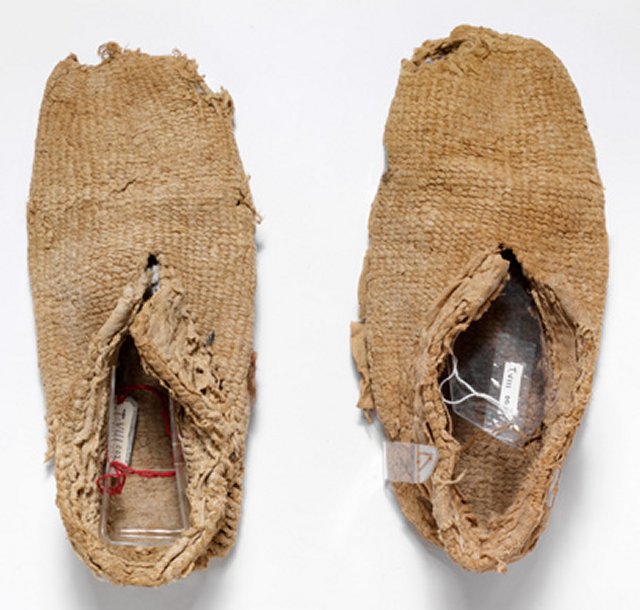
Pair of shoes. Central Asia. Western Han dynasty, 206 BC-10 AD. Plain weave in plant fiber, felted wool, and leather Width 12 cm x length 26.5 cm. Museum no. LOAN: STEIN.55 (T.VIII.002) © Victoria and Albert Museum, London
The wall once guarded by the tower had passed to the north of it, with a bastion-like projection at about six yards' distance.... "(Stein, II, p. 50)
Within the towers, Stein found an astounding range of artifacts, which provide a glimpse of garrison life and military operations under the Han Empire, including bronze mirrors, coarse pottery, tools, leather armor, weapons, shoes, and clothing.
Ancient documents included personal letters on silk and wood, military directives and supply lists, and treatises on a range of subjects, including medicine and astrology.
Stein's third expedition was also fruitful. He contributed hundreds of artifacts, manuscripts, and silks to the British Museum.
He discovered ancient tombs, found lost ancient languages, unearthed the first printed book and much more. However, after Stein's expeditions, the Chinese denied any further excavations in their ancient sites. He and other foreign archaeologists robbed China of its history.
Written by – A. Sutherland AncientPages.com Staff Writer
Copyright © AncientPages.com All rights reserved. This material may not be published, broadcast, rewritten or redistributed in whole or part without the express written permission of AncientPages.com
Expand for referencesMore From Ancient Pages
-
 What Is The Avoidance Custom Of The Amish People In Pennsylvania?
Ancient History Facts | Jul 29, 2019
What Is The Avoidance Custom Of The Amish People In Pennsylvania?
Ancient History Facts | Jul 29, 2019 -
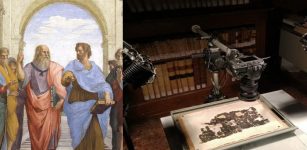 Has A Herculaneum Scroll Solved The Mystery Of Plato’s Death?
Linguistic Discoveries | May 8, 2024
Has A Herculaneum Scroll Solved The Mystery Of Plato’s Death?
Linguistic Discoveries | May 8, 2024 -
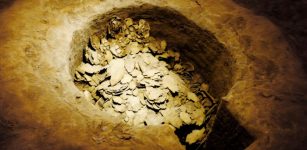 Controversial Theory Suggests Ancient Egyptians Were Founders Of Chinese Civilization
Archaeology | Sep 5, 2016
Controversial Theory Suggests Ancient Egyptians Were Founders Of Chinese Civilization
Archaeology | Sep 5, 2016 -
 525-Million-Year-Old Fossil Defies Textbook Explanation For Brain Evolution
Archaeology | Nov 25, 2022
525-Million-Year-Old Fossil Defies Textbook Explanation For Brain Evolution
Archaeology | Nov 25, 2022 -
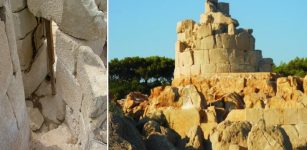 Patara Lighthouse Built By Emperor Nero In 64 AD Will Shine Again
Archaeology | Mar 5, 2020
Patara Lighthouse Built By Emperor Nero In 64 AD Will Shine Again
Archaeology | Mar 5, 2020 -
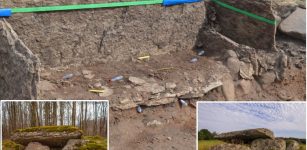 Mystery Of The Unique Tiarp Dolmen – One Of Oldest The Stone Burial Chambers In Scandinavia
Archaeology | Jan 30, 2024
Mystery Of The Unique Tiarp Dolmen – One Of Oldest The Stone Burial Chambers In Scandinavia
Archaeology | Jan 30, 2024 -
 Viking Longships: Fearless Dragonships Daring The Oceans And Seas
Ancient History Facts | Apr 16, 2016
Viking Longships: Fearless Dragonships Daring The Oceans And Seas
Ancient History Facts | Apr 16, 2016 -
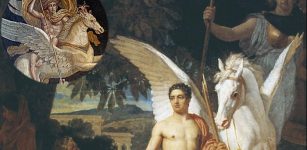 Bellerophon: Great Hero Of Homer’s Iliad Who Was Punished By Gods For His Pride And Arrogance
Featured Stories | Jul 13, 2021
Bellerophon: Great Hero Of Homer’s Iliad Who Was Punished By Gods For His Pride And Arrogance
Featured Stories | Jul 13, 2021 -
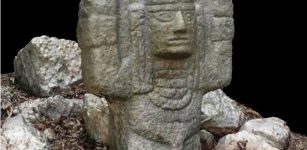 Ancient Atlantean Sculpture Discovered At The Mayan Chichen Itza Archaeological Site
Archaeology | Aug 29, 2023
Ancient Atlantean Sculpture Discovered At The Mayan Chichen Itza Archaeological Site
Archaeology | Aug 29, 2023 -
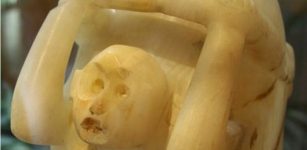 Pulque: Ancient Drink Of The Gods Is Popular Again But It Has Odd Side-Effects
Ancient Traditions And Customs | Jun 29, 2017
Pulque: Ancient Drink Of The Gods Is Popular Again But It Has Odd Side-Effects
Ancient Traditions And Customs | Jun 29, 2017 -
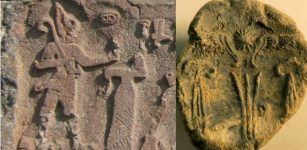 Ancient Clay Seals That Could Re-Write Hittite History Discovered In Kayalıpınar, Turkey
Archaeology | Sep 14, 2023
Ancient Clay Seals That Could Re-Write Hittite History Discovered In Kayalıpınar, Turkey
Archaeology | Sep 14, 2023 -
 Could Shipworms Be Destroying The Wreck Of Captain Cook’s Endeavour?
Archaeology | Aug 18, 2022
Could Shipworms Be Destroying The Wreck Of Captain Cook’s Endeavour?
Archaeology | Aug 18, 2022 -
 Ancient Bone Reveals Syphilis May Have Originated In The Americas – Columbus Theory Questioned By Scientists
Archaeology | Dec 20, 2024
Ancient Bone Reveals Syphilis May Have Originated In The Americas – Columbus Theory Questioned By Scientists
Archaeology | Dec 20, 2024 -
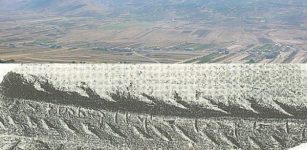 Puzzling McClelland Sherd – Undeciphered Inscription Could Be Early Bronze Age Writing
Artifacts | Mar 27, 2018
Puzzling McClelland Sherd – Undeciphered Inscription Could Be Early Bronze Age Writing
Artifacts | Mar 27, 2018 -
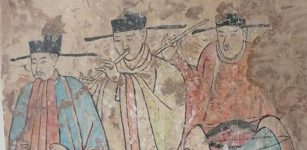 Ancient Fresco Tomb Dated A 1000-Years Ago Was Accidentally Discovered In Northern China
Archaeology | May 5, 2020
Ancient Fresco Tomb Dated A 1000-Years Ago Was Accidentally Discovered In Northern China
Archaeology | May 5, 2020 -
 Cyrus The Great Cylinder – Legacy Of The Ancients
Artifacts | Aug 25, 2015
Cyrus The Great Cylinder – Legacy Of The Ancients
Artifacts | Aug 25, 2015 -
 A Stone Age Child Buried With Bird Feathers, Plant Fibers And Fur Investigated In Finland
Archaeology | Nov 2, 2022
A Stone Age Child Buried With Bird Feathers, Plant Fibers And Fur Investigated In Finland
Archaeology | Nov 2, 2022 -
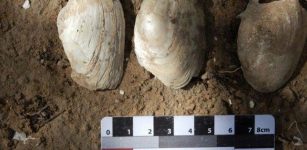 Aboriginals Inhabited South Australia 29,000 Years Ago – New Study
Archaeology | Jul 15, 2020
Aboriginals Inhabited South Australia 29,000 Years Ago – New Study
Archaeology | Jul 15, 2020 -
 Ancient Tomb Of ‘Bird Oracle Markos’ Unearthed In Bergama (Pergamon), Turkey
Archaeology | Sep 6, 2022
Ancient Tomb Of ‘Bird Oracle Markos’ Unearthed In Bergama (Pergamon), Turkey
Archaeology | Sep 6, 2022 -
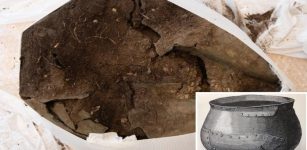 Rare Ancient Roman Cauldron Discovered In Central Norway
Archaeology | Sep 16, 2019
Rare Ancient Roman Cauldron Discovered In Central Norway
Archaeology | Sep 16, 2019


